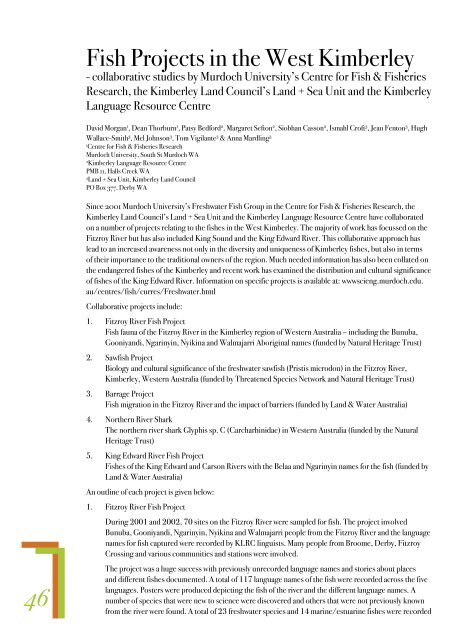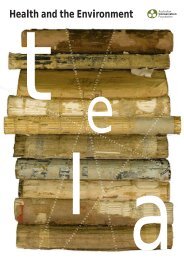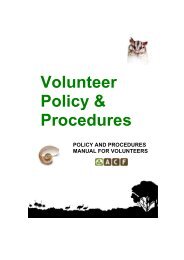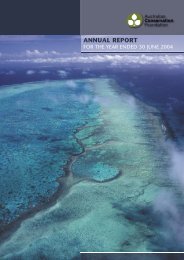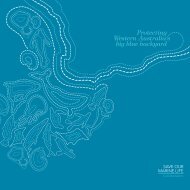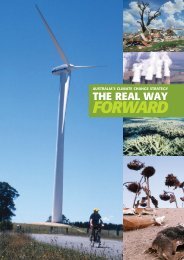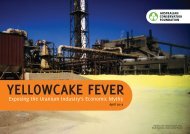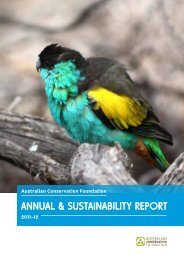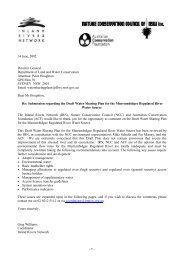Kimberley Appropriate Economics Interim Report - Australian ...
Kimberley Appropriate Economics Interim Report - Australian ...
Kimberley Appropriate Economics Interim Report - Australian ...
Create successful ePaper yourself
Turn your PDF publications into a flip-book with our unique Google optimized e-Paper software.
Fish Projects in the West <strong>Kimberley</strong><br />
- collaborative studies by Murdoch University’s Centre for Fish & Fisheries<br />
Research, the <strong>Kimberley</strong> Land Council’s Land + Sea Unit and the <strong>Kimberley</strong><br />
Language Resource Centre<br />
David Morgan 1 , Dean Thorburn 1 , Patsy Bedford 2 , Margaret Sefton 2 , Siobhan Casson 2 , Ismahl Croft 3 , Jean Fenton 3 , Hugh<br />
Wallace-Smith 3 , Mel Johnson 3 , Tom Vigilante 3 & Anna Mardling 3<br />
1<br />
Centre for Fish & Fisheries Research<br />
Murdoch University, South St Murdoch WA<br />
2<br />
<strong>Kimberley</strong> Language Resource Centre<br />
PMB 11, Halls Creek WA<br />
3<br />
Land + Sea Unit, <strong>Kimberley</strong> Land Council<br />
PO Box 377, Derby WA<br />
46<br />
Since 2001 Murdoch University’s Freshwater Fish Group in the Centre for Fish & Fisheries Research, the<br />
<strong>Kimberley</strong> Land Council’s Land + Sea Unit and the <strong>Kimberley</strong> Language Resource Centre have collaborated<br />
on a number of projects relating to the fishes in the West <strong>Kimberley</strong>. The majority of work has focussed on the<br />
Fitzroy River but has also included King Sound and the King Edward River. This collaborative approach has<br />
lead to an increased awareness not only in the diversity and uniqueness of <strong>Kimberley</strong> fishes, but also in terms<br />
of their importance to the traditional owners of the region. Much needed information has also been collated on<br />
the endangered fishes of the <strong>Kimberley</strong> and recent work has examined the distribution and cultural significance<br />
of fishes of the King Edward River. Information on specific projects is available at: wwwscieng.murdoch.edu.<br />
au/centres/fish/curres/Freshwater.html<br />
Collaborative projects include:<br />
1. Fitzroy River Fish Project<br />
Fish fauna of the Fitzroy River in the <strong>Kimberley</strong> region of Western Australia – including the Bunuba,<br />
Gooniyandi, Ngarinyin, Nyikina and Walmajarri Aboriginal names (funded by Natural Heritage Trust)<br />
2. Sawfish Project<br />
Biology and cultural significance of the freshwater sawfish (Pristis microdon) in the Fitzroy River,<br />
<strong>Kimberley</strong>, Western Australia (funded by Threatened Species Network and Natural Heritage Trust)<br />
3. Barrage Project<br />
Fish migration in the Fitzroy River and the impact of barriers (funded by Land & Water Australia)<br />
4. Northern River Shark<br />
The northern river shark Glyphis sp. C (Carcharhinidae) in Western Australia (funded by the Natural<br />
Heritage Trust)<br />
5. King Edward River Fish Project<br />
Fishes of the King Edward and Carson Rivers with the Belaa and Ngarinyin names for the fish (funded by<br />
Land & Water Australia)<br />
An outline of each project is given below:<br />
1. Fitzroy River Fish Project<br />
During 2001 and 2002, 70 sites on the Fitzroy River were sampled for fish. The project involved<br />
Bunuba, Gooniyandi, Ngarinyin, Nyikina and Walmajarri people from the Fitzroy River and the language<br />
names for fish captured were recorded by KLRC linguists. Many people from Broome, Derby, Fitzroy<br />
Crossing and various communities and stations were involved.<br />
The project was a huge success with previously unrecorded language names and stories about places<br />
and different fishes documented. A total of 117 language names of the fish were recorded across the five<br />
languages. Posters were produced depicting the fish of the river and the different language names. A<br />
number of species that were new to science were discovered and others that were not previously known<br />
from the river were found. A total of 23 freshwater species and 14 marine/estuarine fishes were recorded


